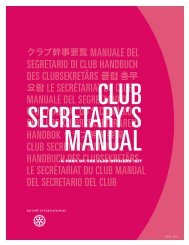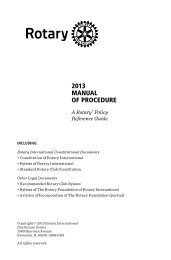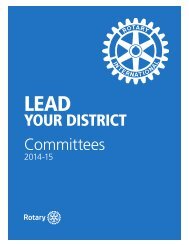DISCURSOS - Rotary International
DISCURSOS - Rotary International
DISCURSOS - Rotary International
You also want an ePaper? Increase the reach of your titles
YUMPU automatically turns print PDFs into web optimized ePapers that Google loves.
Public Image<br />
Bernard Attard<br />
RI Training Leader and <strong>Rotary</strong> Public Image Coordinator<br />
Hello.<br />
During the past few days, I am sure that you have enjoyed some delicious Häagen-Dazs ice<br />
cream. Have you ever wondered where the name Häagen-Dazs comes from? At first, the explanation<br />
seems fairly logical: Two business partners, Mr. Häagen and Mr. Dazs, got together to<br />
make some ice cream and conquer the world. In a way, they were the Old World’s Ben and Jerry.<br />
If you believe this explanation, you are seriously mistaken.<br />
I made up the names of these two people. The two individuals who started the company were<br />
indeed ice cream makers, but they were from New York and their names were Reuben and Rose<br />
Mattus. When they chose the name Häagen-Dazs in the 1960s, these Polish immigrants tried to<br />
ride the wave of Danish products that were then enjoying a great reputation in the United States<br />
and to take advantage of the positive image associated with European craftsmanship.<br />
I chose this example — from among many others — to show you that when it comes to communication,<br />
you must first have a strategy.<br />
There is no communication without a communication strategy.<br />
A communication strategy must include some references to the entity’s history, identity, values,<br />
and purpose. It must show a direction. It must carry a meaning, which is the main objective of a<br />
communication process.<br />
A common mistake is to start with the means rather than the end.<br />
With a communication strategy, you move from a passive to an active role. This strategy should<br />
also be developed parallel to the strategic plan of the organization. With planned communication,<br />
we can help prevent inconsistency in our operations.<br />
An audit should be the first step of the plan. It is often ignored because the focus is on the final<br />
goal, and the current situation can be easily, if not intuitively, grasped.<br />
Such a review is nevertheless essential.<br />
You might ask yourselves: Why should we communicate? After all, we are not a corporation,<br />
even though we are all professionals. In <strong>Rotary</strong>, we are volunteers; we are the stewards of core<br />
values. And many worry that opinion-making is taking precedence over civil society.<br />
A corporation sells goods and services in order to compensate its shareholders. Its communication<br />
aims at convincing customers to buy its products. In our case, the goal is to connect our<br />
members and the stakeholders around us. Our communication is based on connections. This is a<br />
crucial difference.<br />
A social communication can drive opinion-making to create awareness of a cause or an issue and<br />
can encourage people to give money or time to support our projects.<br />
Moreover, our movement is driven by recognition. For a corporation, the main engine is profits,<br />
even though recognition plays a part.<br />
<strong>International</strong> Assembly Speeches 2013 33



![La présidence du club [222-FR] - Rotary International](https://img.yumpu.com/25855726/1/190x245/la-presidence-du-club-222-fr-rotary-international.jpg?quality=85)











![La conférence de district [800-FR] - Rotary International](https://img.yumpu.com/25855636/1/190x245/la-conference-de-district-800-fr-rotary-international.jpg?quality=85)
